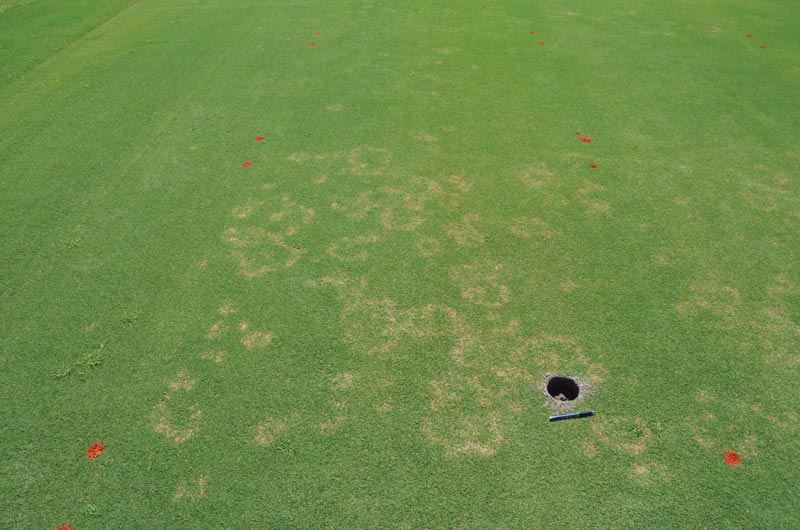
Photo by Luke Dant
The turf disease rhizoctonia leaf and sheath spot (RLSS), commonly referred to as “mini-ring,” has been problematic in ultradwarf bermudagrass putting greens since the late 1990s.
In the transition zone, symptoms appear in late summer as frog-eye patches
4 to 18 inches (10-46 cm) in diameter and become more distinct in late fall as ultradwarf bermudagrass growth slows. Symptoms are often most severe in ultradwarf bermudagrass that is managed with low nitrogen fertility. The purported causal agent, Rhizoctonia zeae, is frequently isolated from symptomatic turf, but disease epidemiology has not been extensively researched.
Seasonal activity of R. zeae was studied by performing isolations from an ultradwarf bermudagrass putting green with RLSS symptoms from June through October in 2016 and 2017. Rhizoctonia zeae was isolated from ultradwarf bermudagrass leaf tissue in the months of June, July, August and September, yet isolation frequency was greatest in the latter two months.
To investigate the impact of nitrogen on RLSS development, in 2016 and 2017, nitrogen, in the form of ammonium sulfate or urea, was applied to a MiniVerde and a TifEagle putting green at rates of 0.10, 0.20 and 0.30 pounds (45.3, 90.7 and 136.0 grams) nitrogen per growing week.
RLSS severity increased in both cultivars as the rate of ammonium sulfate increased. In contrast, RLSS severity decreased as the rate of urea increased. It appears that RLSS is consistently associated with R. zeae and that infection likely takes place from midsummer to early fall. Ultradwarf bermudagrass fertilized with urea showed less disease severity than turf treated with ammonium sulfate.
— Luke Dant and S.B. Martin, Ph.D., Clemson University, Florence, S.C.; L.B. McCarty, Ph.D., Clemson University, Clemson, S.C.; and J.P. Kerns, Ph.D., North Carolina State University, Raleigh, N.C.
Teresa Carson is GCM’s science editor.